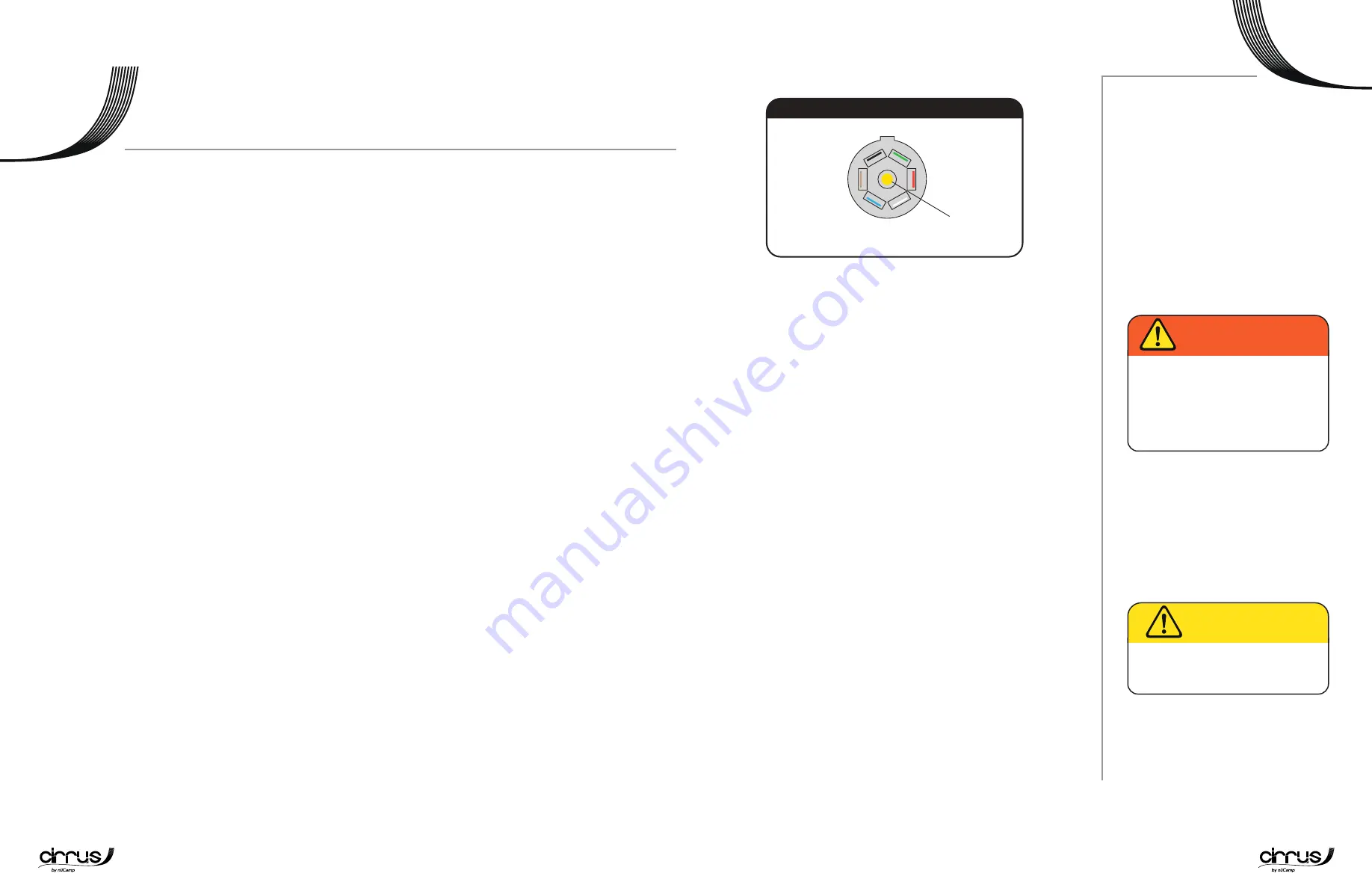
nucamprv.com • Truck Campers
21
20
Truck Campers • nucamprv.com
• Use caution when loading and unloading the camper on a windy day. The amount of wind that
is dangerous depends on your exposure and the weight of the camper. It is best to avoid loading
on a windy day.
• Always keep the front higher than the rear. Before loading the camper onto the truck, be sure to
attach the tie-downs to the truck.
Step by step instructions for loading your camper:
1. Extend each jack no more than four inches at once. Starting with the front jacks, keeping the
camper level always. Repeat this process until the camper clears the truck body bed by
approximately four inches.
2. Slowly back truck under camper making sure to clear wheel wells and any structure or plumbing
located below the living area. This will come easier with some practice.
3. Continue backing until the truck is within a foot of loaded position. Stop and connect the 7-way
power cord to the 7-way receptacle in the truck bed.
4. Continue backing under the camper until the rubber bumpers mounted on the front wall in the
truck bed lightly touch the front of the camper.
5. Slowly retract both rear jacks, then front jacks until the camper is resting fully on the truck bed.
6. Retract the jacks completely and secure in place per the manufacturer’s instructions.
7. Lift and swing front jacks inward (if equipped with swing-out brackets).
8. Secure the camper to the truck with turnbuckles. The front turnbuckles must be spring-
loaded, while the rear should use solid turnbuckles. Install both the front and rear turnbuckles
per manufacturer’s instructions. Turnbuckles should never be overtightened. They should be
snug enough to keep them securely in place but not so tight that it puts stress on the camper’s
outer floor. The turnbuckle is designed to keep your camper from moving backward as opposed
to holding your camper down.
Step by step instructions for unloading your camper:
1. Position the truck/camper combination on firm, level, ground. If needed use 12" square ¾"
plywood support pads under each jack to prevent sinking if the ground is soft.
2. Disconnect and remove the following items:
a. Front and rear turnbuckles/tiedowns
b. 7-way camper power cord
3. Using your remote control, operate all jacks together until the camper clears the truck bed by
four inches.
4. If necessary, operate the jacks individually starting with the front jacks. Extend the jacks no
more than 4" at a time. Keep the camper as level as possible. Repeat the process until the
camper has cleared the truck bed by approximately 4".
5. Slowly drive the truck from under the camper until it clears the camper and the front overhang.
6. Lower the camper with the rear jacks first, then lower the front jacks no more than four inches at
a time.
CONNECTOR PLUG
Before each trip:
1. Plug the 7-way connector plug into the hauling vehicle socket and
verify that the driving lights on the side and rear of trailer light up.
2. Have someone stand behind the camper and confirm lights are
working when you perform next steps.
a. Step on the tow vehicle brakes. Brake lights should light up.
b. Turn on right/left turn signals and verify that the appropriate
lights come on.
c. With your foot on the brake, put your vehicle in reverse and
verify that the backup lights come on.
3. If any of the lights do not function as expected, the system may
need serviced.
The 7-way connector plug and the wire harness from the underbelly,
supplies power from the hauling vehicle to brake, turn signal, driving and
backup lights in your camper. It may build up corrosion over time. Clean
the connector plug frequently to ensure good electrical contact.
STABILIZING & SETUP
Important points to observe:
• After unloading the camper, always lower camper down close to
ground level.
• Do not enter or occupy the camper before lowering it the ground
where it is ready for use. Your camper is designed to be used
while standing on the jacks in a lowered position.
• When lowering the camper, do not allow the bumper to touch the
ground. Allow a minimum of two inches of clearance to the ground
from the lowest point of the camper.
• Always level the camper front to back and side to side. This will
allow your equipment and water drainage to function properly.
• Make sure that all four jacks are touching the ground. If one jack is
off the ground it may cause the camper to rock and feel unsteady
when walking inside.
Right Turn/Stop
(BROWN)
Left Turn/Stop
(RED)
Charge
(BLACK)
Tail/Running Lights
(GREEN)
Brakes/Open
(BLUE)
Ground
(WHITE)
Backup Lights
(Yellow)
RV Industry Standard 7-Way Plug
Malfunctioning or disconnected lights
on your camper while driving is not only
illegal but may result in traffic accidents
due to limited visibility of your trailer by
other vehicles. Loss of control, serious
injury or death can result.
WARNING
Always level your camper when in use.
Failure to level can cause water leaks,
refrigerator failure or other damage.
CAUTION





























